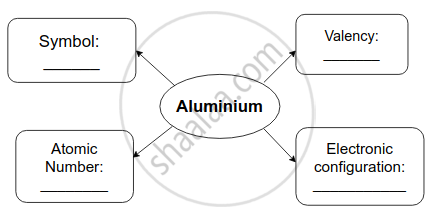Advertisements
Advertisements
प्रश्न
Explain Bayer’s process.
उत्तर
- In Bayer’s process, the bauxite ore is first crushed and then it is leached by heating with hot concentrated caustic soda (NaOH) solution under high pressure for 2 to 8 hrs at 140 to 150 °C in a tank called a digester.
- Aluminium oxide, being amphoteric in nature, dissolves in an aqueous NaOH solution, forming water-soluble sodium aluminate.
\[\ce{\underset{\text{oxide}}{\underset{\text{Aluminium}}{Al2O3.2H2O_{(s)}}} + \underset{\text{hydroxide}}{\underset{\text{Sodium}}{2NaOH_{(aq)}}} -> \underset{\text{aluminate}}{\underset{\text{Sodium}}{2NaAlO_{2(aq)}}} + \underset{\text{Water}}{3H2O_{(l)}}}\] - The iron oxide present in the gangue does not dissolve in aqueous NaOH solution and is separated by filtration.
- However, silica from the gangue dissolves in aqueous NaOH solution forming water-soluble sodium silicate.
- The solution of sodium aluminate is diluted with water and then cooled to 50 °C. This gives aluminium hydroxide as a precipitate.
\[\ce{\underset{\text{aluminate}}{\underset{\text{Sodium}}{NaAlO_{2(aq)}}} + \underset{\text{Water}}{2H2O_{(l)}} -> \underset{\text{hydroxide}}{\underset{\text{Sodium}}{NaOH_{(aq)}}} + \underset{\text{hydroxide}}{\underset{\text{Aluminium}}{Al(OH)_3↓}}}\] - The aluminium hydroxide is then filtered, washed, dried and calcined by heating at 1000 °C to get pure aluminium oxide, called alumina.
\[\ce{\underset{\text{hydroxide}}{\underset{\text{Aluminium}}{2Al(OH)_{3(s)}}} ->[heat][1000°C] \underset{\text{oxide}}{\underset{\text{Aluminium}}{Al2O_{3(s)}}} + \underset{\text{vapour}}{\underset{\text{Water}}{3H2O_{(g)}}}}\]
APPEARS IN
संबंधित प्रश्न
Name the following:
The property possessed by metals by which they can be beaten into sheets.
The process by which sulphide ore is concentrated.
Name one metal which is extracted by reduction with carbon.
Define the terms gangue.
The two metals which can be extracted just by heating their sulphides in air are:
(a) sodium and copper
(b) copper and aluminium
(c) potassium and zinc
(d) mercury and copper
State why aluminium is extracted from its oxide by electrolysis while copper, lead, iron by reducing agents and mercury and silver by thermal decomposition.
Give reasons, why aluminum is used in:
In aluminiothermy
Name the following:
The process of heating a substance very strongly in such a way that it does not combine with oxygen.
What is meant by concentration of ores?
Compare the process of calcination and roasting.
The following question relate to the extraction of aluminium by electrolysis.
Give the equation for the reaction which takes place at the cathode.
X is an element in the form of a powder. X burns in oxygen and the product is soluble in water. The solution is tested with litmus. Write down only the word which will correctly complete each of the following sentences:
(a) If X is a metal, then the litmus will turn ______.
(b) If X is a non-metal, then the litmus will turn ______.
(c) If X is a reactive metal, then ______ will be evolved, when X reacts with dilute sulphuric acid.
(d) If X is a non -metal, it will form _ oxide, which will form ______ solution with water.
(e) If X is a non -metal, it will not conduct electricity unless it is carbon in the form of ______.
Name the following:
The process of heating an ore to a high temperature in the presence of air.
Name the methods by which concentrated ore is converted to metallic oxide.
State three objectives achieved during the roasting of ores.
What is the difference between calcination and roasting?
Name the process used for the enrichment of sulphide ore.
Complete flow chart given below.

The poorest conductor of heat among metals is ____________.
Oxides of moderately reactive metals like Zinc, Iron, Nickel, Tin, Copper, etc. are reduced by using:
